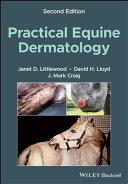Practical Equine Dermatology, 2nd Edition

Praktická a komplexní referenční příručka koňských dermatologických případů. Nově přepracované druhé vydání přináší důkladný přehled běžných dermatologických stavů postihujících koně a zároveň upozorňuje na vzácnější kazuistiky.
Publikace nabízí podrobné rady o terapii a produktech, které jsou v současnosti dostupné na veterinárním trhu. Autoři publikaci uspořádali podle kožních problémů a poskytuje praktický přístup k rychlé a účinné diagnostice. Klinické prezentace, diagnostické funkce a léčba dermatologických poruch pro každý popsaný stav jsou prezentovány ve snadno přehledném formátu s odrážkou podpořeným stručnými odkazy a doporučeními pro další studium.
Nové vydání je ideální rychlou referencí pro veterinární lékaře o klíčových dermatologických bodech onemocnění koní a obsahuje také:
Důkladný úvod do diagnostického přístupu, včetně přesné anamnézy, klinického vyšetření a diagnostických testů.
Komplexní posouzení pruritu, vyšetření včetně infekčních stavů, jako jsou ektoparazité a napadení hlísty, a neinfekčních stavů, jako je napadení hmyzem a atopická dermatitida.
Praktická diskuze o tvorbě krust a šupinatění, včetně primární seborey a infekčních příčin, jako jsou povrchové plísňové infekce a faktory prostředí.
Hloubkové vyšetření vředů a erozí, uzlů a otoků, problémů se srstí a poruch pigmentace.
Praktická koňská dermatologie je ideální nejen pro každého praktického veterináře v terénu, ale i pro studenty veterinární medicíny se zájmem o veterinární medicínu koní.
Autor: Janet D. Littlewood, David H. Lloyd, J. Mark Craig Littlewood
| Nakladatel | Wiley-Blackwell |
|---|---|
| ISBN | 9781119765486 |
| Vydání | II. vydání 2022 |
| Vazba | brožovaná |
| Počet stran | 208 |
A practical and comprehensive reference for equine dermatology cases
The newly revised Second Edition of Practical Equine Dermatology delivers a thorough exploration of common dermatological conditions affecting horses whilst also drawing attention to rarer conditions.
The book offers detailed advice on treatments and products currently available on the veterinary market in a problem-oriented layout that provides a practical approach to quick and efficient diagnosis. Clinical presentations, diagnostic features, and disorder management for each described condition are presented in an easy-to-digest bullet-point format supported by concise references and recommendations for further reading.
An ideal quick reference for veterinary practitioners on the key points of equine skin conditions, this new edition also includes:
A thorough introduction to the diagnostic approach, including taking an accurate history, the clinical examination, and diagnostic tests.
Comprehensive exploration of pruritus, including contagious conditions, such as ectoparasites and helminth infestation, and non-contagious conditions, such as insect attack and atopic dermatitis.
Practical discussion of crusting and scaling, including primary seborrhoea and infectious causes, such as superficial fungal infections and environmental factors.
In-depth examination of ulcers and erosions, nodules and swellings, coat problems, and pigmentary disorders.
Perfect for any practising veterinarian seeing equine cases in first opinion practice, Practical Equine Dermatology will also be of use to veterinary students with an interest in equine veterinary medicine.
Autors:
Janet D. Littlewood is a Specialist Veterinary Dermatologist and Consultant at Rossdales Equine Hospital, Suffolk, UK.
David H. Lloyd is Emeritus Professor of Veterinary Dermatology at the Royal Veterinary College, UK.
J. Mark Craig is a Veterinary Dermatologist, Re-Fur-All Referrals, Newbury, UK.
| Preface to the second edition | ix |
| Acknowledgements | xi |
| Disclaimer | xii |
| 1 The diagnostic approach | 1 |
| Taking the history | 1 |
| Clinical examination | 3 |
| Diagnostic tests | 4 |
| References and Further reading | 12 |
| 2 Pruritus | 13 |
| Contagious conditions | 14 |
| Ectoparasitic infestations | 14 |
| Free-living mite infestations | 19 |
| Helminth infestations | 23 |
| Microbial infections | 24 |
| Non-contagious conditions | 26 |
| Hypersensitivity disorders | 27 |
| Immune-mediated disease | 35 |
| Neoplasia | 35 |
| Neurogenic pruritus | 35 |
| References and Further reading | 36 |
| 3 Crusting and Scaling | 37 |
| Idiopathic seborrhoeic conditions | 37 |
| Secondary, acquired keratinisation and crusting disorders | 40 |
| Infectious causes | 40 |
| Immune-mediated causes | 52 |
| Environmental causes | 61 |
| Uncertain aetiology | 63 |
| References and Further reading | 75 |
| 4 Ulcers and Erosions | 77 |
| Contagious causes | 77 |
| Immune-mediated causes | 83 |
| Congenital and hereditary causes | 90 |
| Environmental causes | 95 |
| Neoplastic causes | 99 |
| Miscellaneous dermatoses | 99 |
| References and Further reading | 105 |
| 5 Papules, Nodules, and Masses | 106 |
| Physical conditions | 106 |
| Cysts | 110 |
| Viral conditions | 113 |
| Bacterial infections | 119 |
| Fungal infections | 128 |
| Parasitic conditions | 132 |
| Immune-mediated conditions | 135 |
| Neoplasia | 140 |
| Miscellaneous causes | 154 |
| References and Further reading | 166 |
| 6 Coat Problems | 168 |
| Alopecia | 168 |
| Other abnormalities | 178 |
| References and Further reading | 182 |
| 7 Pigmentary Disorders | 183 |
| Genetics of skin and coat colour | 183 |
| Hypopigmentation disorders | 185 |
| Hyperpigmentation | 192 |
| References and Further reading | 192 |
| 8 Therapy in Equine Dermatology | 193 |
| Availability of veterinary medicines for equine patients | 193 |
| References and Further reading | 194 |
| Index | 196 |